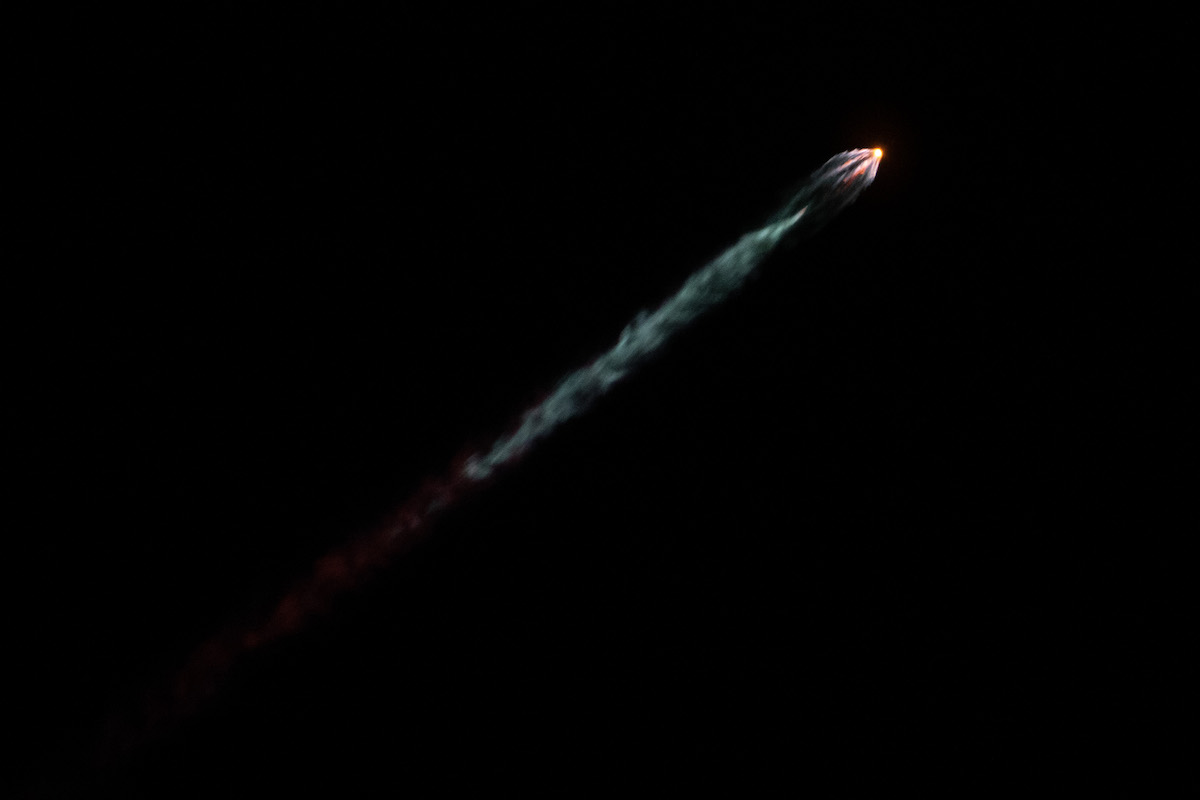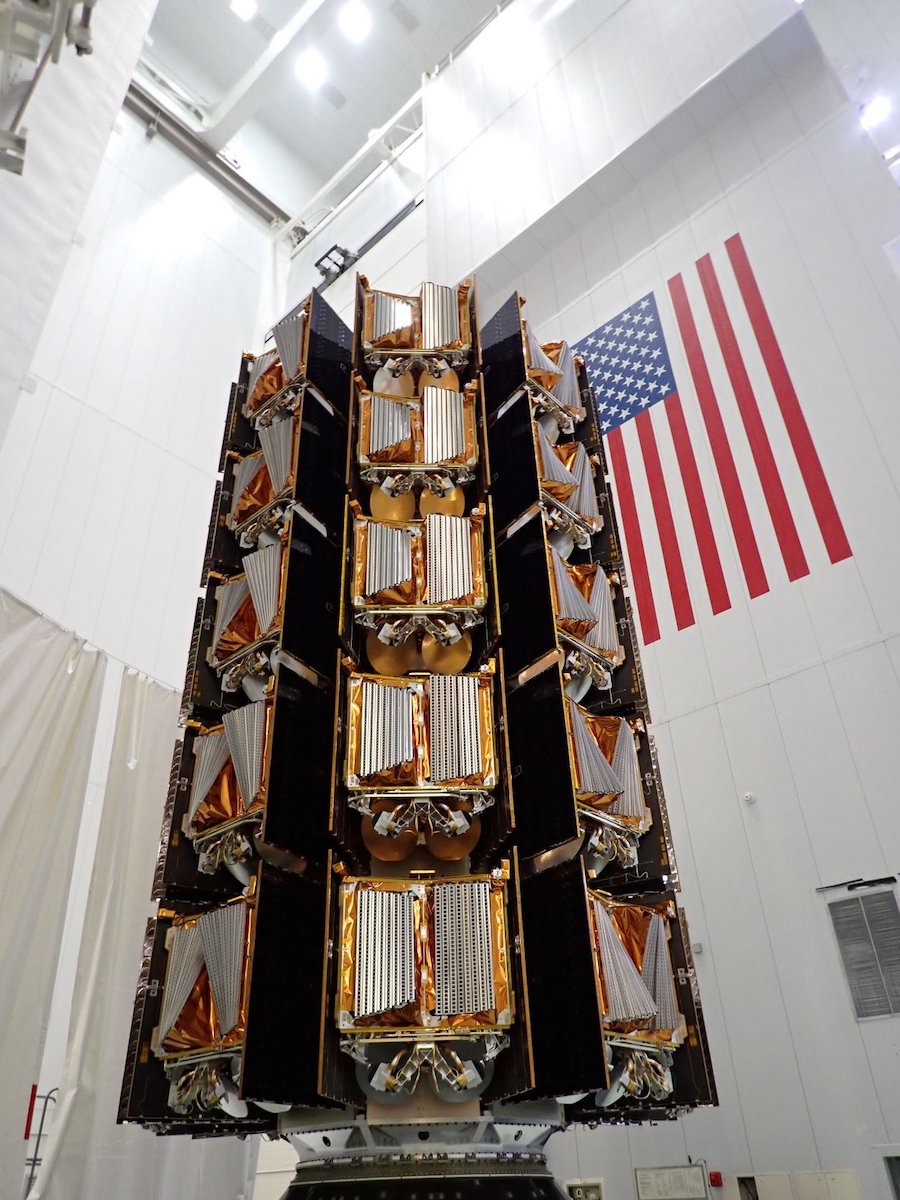Watch a replay of our coverage of the countdown and launch of a SpaceX Falcon 9 rocket at 11:50 p.m. EST (0450 GMT) from Space Launch Complex 40 at Cape Canaveral Space Force Station, Florida, with 40 OneWeb internet satellites. Follow us on Twitter.
SFN Live
A SpaceX Falcon 9 rocket lifted off from Cape Canaveral Monday night with 40 more internet satellites for OneWeb, nudging the network closer to full operational capability. The Falcon 9 booster returned to Cape Canaveral for landing eight minutes later.
The 229-foot-tall (70-meter) Falcon 9 rocket lifted off from pad 40 at Cape Canaveral Space Force Station at 11:50:17 p.m. EST (0450:17 GMT). The launcher thundered into the sky on the power of 1.7 million pounds of thrust from nine kerosene-fueled Merlin main engines, kicking off SpaceX’s second mission of the year.
SpaceX delayed the launch of a different Falcon 9 rocket from Vandenberg Space Force Base in California Monday night due to bad weather. That mission was supposed to launch just 35 minutes before the OneWeb mission from Cape Canaveral, but has now been rescheduled for liftoff Tuesday night.
The SpaceX launch team working in a control center just outside the gate of Cape Canaveral Space Force Station began loading super-chilled, densified kerosene and liquid oxygen propellants into the Falcon 9 vehicle at T-minus 35 minutes.
Helium pressurant also flowed into the rocket in the last half-hour of the countdown. In the final seven minutes before liftoff, the Falcon 9’s Merlin main engines were thermally conditioned for flight through a procedure known as “chilldown.” The Falcon 9’s guidance and range safety systems were also configured for launch.

After liftoff, the Falcon 9 rocket vectored its to steer downrange toward the southeast over the Atlantic Ocean, then the launcher turned south to fly parallel to Florida’s east coast, aiming for a polar orbit at an inclination of 87 degrees.
The launcher surpassed the speed of sound in about one minute, then shut down its nine main engines nearly two-and-a-half minutes after liftoff.
The booster stage separated from the Falcon 9’s upper stage, then fired pulses from cold gas control thrusters and extended titanium grid fins to help steer the vehicle back into the atmosphere. The lighter weight of the 40 OneWeb satellites allowed the Falcon 9 booster to set aside enough fuel to return to the launch site, which requires an additional engine burn compared to rocket landings on SpaceX’s ocean-going drone ships.
Landing of the first stage on Landing Zone 1 at Cape Canaveral occurred about eight minutes into the mission. The returning booster sent a pair of sonic booms across Florida’s Space Coast as it slowed for landing. The first stage, designated B1076, completed its second flight to space on Monday night’s mission.
A recovery ship was also on station in the Atlantic Ocean to retrieve the Falcon 9’s payload fairing after jettisoning from the rocket.
SpaceX launched a Falcon 9 rocket from Cape Canaveral at 11:50pm EST (0450 GMT), carrying 40 internet satellites into a polar orbit for OneWeb. https://t.co/oYLCqEq2lj pic.twitter.com/fK4MZwHbHl
— Spaceflight Now (@SpaceflightNow) January 10, 2023
The Falcon 9’s upper stage fired its single engine two times to reach a near-circular polar orbit close to the mission’s target altitude of 373 miles (600 kilometers). The upper stage released the 40 OneWeb satellites beginning about 59 minutes after liftoff, and SpaceX confirmed all the spacecraft had separated about 1 hour and 35 minutes into the flight.
The OneWeb satellites, built in a factory just outside the gates of Kennedy Space Center, will use xenon-fueled propulsion systems to reach their operating altitude 745 miles (1,200 kilometers) above Earth.
The OneWeb launch from Cape Canaveral Monday night was the second of four planned SpaceX missions for the broadband internet provider, which suspended launches on Russian Soyuz rockets last year after Russia’s invasion of Ukraine. Within weeks, OneWeb signed new contracts with SpaceX and New Space India Ltd., or NSIL, for launches on Falcon 9 and Indian GSLV Mk.3 rockets to finish building out the company’s satellite network.
SpaceX confirms all 40 OneWeb internet satellites have separated from the Falcon 9 rocket in orbit. https://t.co/oYLCqEq2lj pic.twitter.com/YnQIANeaYE
— Spaceflight Now (@SpaceflightNow) January 10, 2023
The 40 satellites on-board the Falcon 9 rocket brought the total number of OneWeb spacecraft launched to 544. OneWeb needs 588 operational satellites to complete its first-generation broadband network, or a total of nearly 650 spacecraft when counting spares.
Adding more relay stations to the constellation extends the network’s reach. London-based OneWeb already provides internet services to communities in Alaska, Canada, and and Northern Europe where terrestrial fiber connectivity is unavailable. The 40 satellites on Monday night’s launch will help put Southern Europe, the United States, North Africa, the Middle East, Japan, and parts of Australia and India within OneWeb’s reach.
OneWeb’s contract with SpaceX was surprising to many satellite industry watchers because OneWeb is an indirect competitor in the broadband market. SpaceX sells Starlink service directly to consumers, while OneWeb sells to enterprises, internet service providers, maritime companies, and airlines to provide connectivity for entire businesses or communities.

ROCKETS: Falcon 9 (B1076.2)
PAYLOADS: 40 OneWeb satellites (OneWeb 16)
LAUNCH SITES: SLC-40, Cape Canaveral Space Force Station, Florida
LAUNCH DATES: Jan. 9, 2023
LAUNCH TIME: 11:50:17 p.m. (0450:17 GMT)
WEATHER FORECAST: Greater than 90% chance of acceptable weather at Cape Canaveral
BOOSTER RECOVERY: Landing Zone 1 at Cape Canaveral Space Force Station
LAUNCH AZIMUTH: Southeast, then south from Cape Canaveral
TARGET ORBIT: 373 miles (600 kilometers), 87 degrees inclination
LAUNCH TIMELINE FOR ONEWEB 16:
- T+00:00: Liftoff
- T+01:12: Maximum aerodynamic pressure (Max-Q)
- T+02:18: First stage main engine cutoff (MECO)
- T+02:21: Stage separation
- T+02:28: Second stage engine ignition
- T+02:34: First stage boost back burn ignition
- T+03:21: First stage boost back burn cutoff
- T+03:34: Fairing jettison
- T+06:20: First stage entry burn ignition
- T+06:36: First stage entry burn cutoff
- T+07:27: First stage landing burn ignition
- T+07:56: First stage landing
- T+08:32: Second stage engine cutoff (SECO 1)
- T+55:14: Second stage engine restart (SES 2)
- T+55:17: Second stage engine cutoff (SECO 2)
- T+58:49: Separation of first OneWeb satellites
- T+01:35:17: Separation of final OneWeb satellites
MISSION STATS:
- 196th launch of a Falcon 9 rocket since 2010
- 205th launch of Falcon rocket family since 2006
- 2nd launch of Falcon 9 booster B1076
- 168th SpaceX launch from Florida’s Space Coast
- 109th Falcon 9 launch from pad 40
- 164th launch overall from pad 40
- 135th flight of a reused Falcon 9 booster
- 2nd SpaceX launch for OneWeb
- 16th overall launch for OneWeb
- 2nd Falcon 9 launch of 2023
- 2nd launch by SpaceX in 2023
- 2nd orbital launch from Cape Canaveral in 2023
Email the author.
Follow Stephen Clark on Twitter: @StephenClark1.
"now" - Google News
January 10, 2023 at 11:13AM
https://ift.tt/sAXft1B
SpaceX sends 40 more OneWeb internet satellites into orbit – Spaceflight Now - Spaceflight Now
"now" - Google News
https://ift.tt/lvxHGQs
Bagikan Berita Ini














0 Response to "SpaceX sends 40 more OneWeb internet satellites into orbit – Spaceflight Now - Spaceflight Now"
Post a Comment